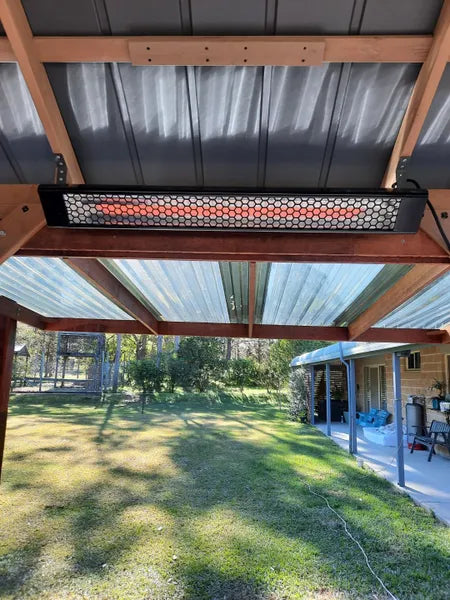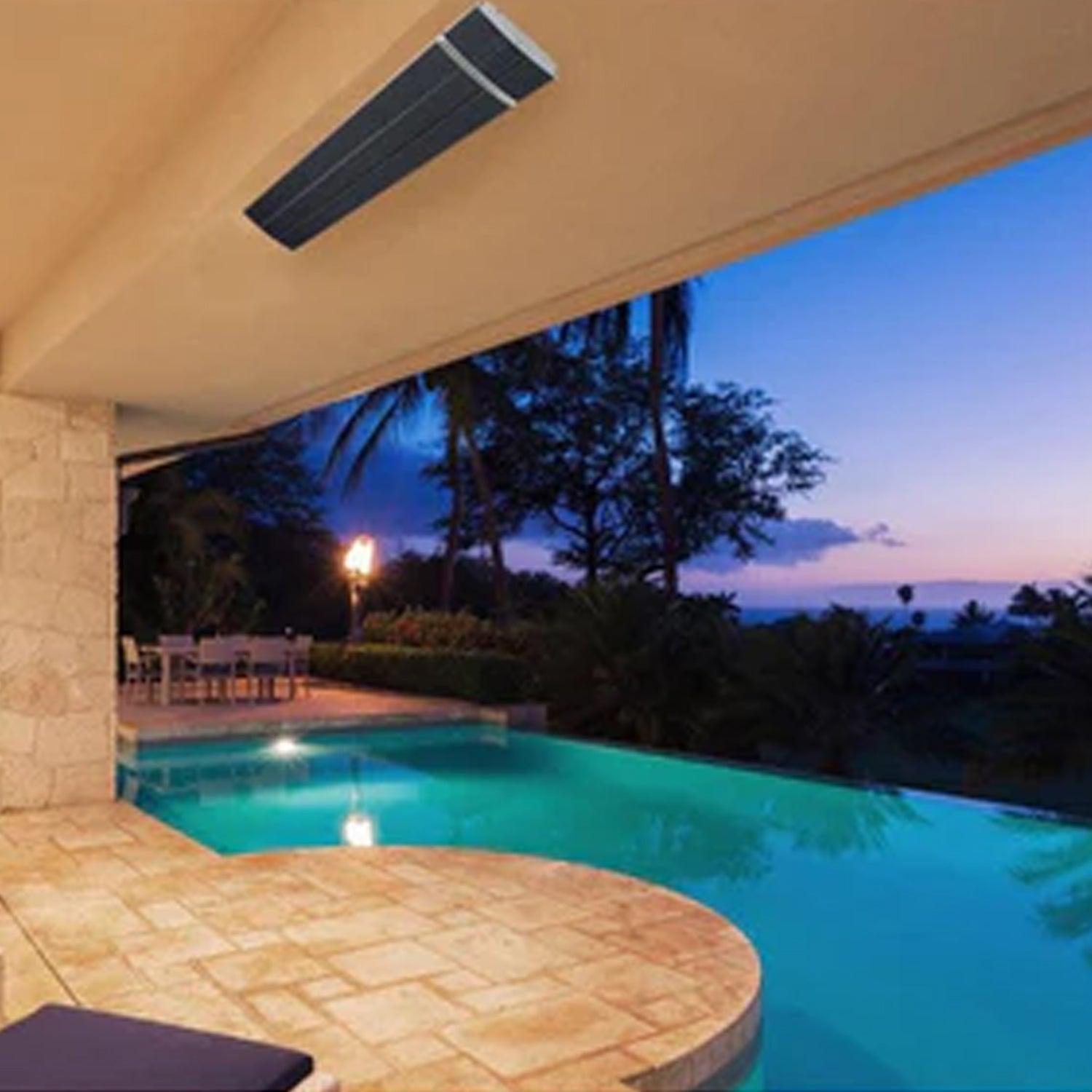As the nights get longer and Summer fades, so too does the hot weather. We’re lucky in many parts of Australia to have mild, beautiful Winters, but they can still be rather chilly. Thankfully, with a good patio heater, we can enjoy the outdoors and dine alfresco even on the coldest nights. No more waiting for spring for a good family BBQ or drinks with friends on the terrace.
With heaps of outdoor heaters available, we are now spoilt for choice. From electric to gas, ceiling-mounted to free-standing, there are heaters for all occasions, locations and budgets. However, all these options make knowing which one to choose so much harder.
At The Lighting Outlet, our team have a wealth of knowledge when it comes to outdoor heaters. To help you find the best heater for your patio or garden, our experts have picked their top heaters for 2024. Read on for their tips on:
- Choosing a gas vs electric heater.
- Installing radiant heaters.
- How to position your outdoor heaters.
- Plus answers to other common questions
Things to consider before you buy
Electric vs Gas Patio Heaters
Our favourite outdoor heaters are the radiant heaters which work by producing a radiant heat that projects directly to skin or objects rather than just heating the air. These are typically electric powered (please see note below on installation). A traditional heater will heat a room which is practical for indoors, but for outdoors the heat simply gets lost in the breeze or wind. So in a nutshell radiant heaters will heat the direct environment, not the air around it.
Gas heaters have many great benefits too, the main benefit being that you get instant heat. When indoors, as soon as the gas heater is turned on the heat will begin to flow through your home but for outdoors you need to be in a close vicinity to the heater as the heat will get lost in the air. Gas heaters also have a lower carbon emissions, the combustion for natural gas is almost 100% which is only a minimal amount being emitted to the atmosphere. Gas heaters are more suited for a commercial purpose like a cafe or beer garden to get instant heat.
Consider Outdoor Heater Power Costs
The power costs for radiant heaters are the same as an infrared heater which are typically around 1500 watts. If you were to run a 1500w radiant heater you would be looking at a running cost of around 50c per hour. Radiant heaters are known to be more efficient as they don't require natural resources. Moving forward into the next 10 to 20 years we hope to see people using more solar renewable energy and then running for free. Gas heaters are more pricey to run (on average will cost $3 per hour) and will also need more maintenance.

Installing Radiant Outdoor Heaters
In the past we have had customers get caught out by them not knowing that they will be required to run the outdoor heater directly from the circuit board on their own circuit, which may be tricky for installation. Anything 1800w or over should be on it’s own circuit so check with your electrician before installing. Radiant electric heaters give radiant heat which heats objects rather than air. It is important that objects to be heated (ie. people), are within the line radiant direction of the heater. The Image below shows the radiant direction of radiant heater and is a guide based on an enclosed outdoor setting. This image shows that the maximum heat output is found directly beneath the heater, and the temperature drops the further away you are from the heater. It shows how important it is maintaining right mounting heights, and if possible, positioning the heater right above the area to be heated. Note that the temperature is similar for all 3 models, regardless of the wattage however, as the size increases and the length of the unit increases, the radiant footprint will be further.

How To Position Your Outdoor Heater
When installing your outdoor patio heater you can look to mount it to the wall, but the best gain would come from installing it above your living table. Having your outdoor heater on the wall or ceiling also takes out the option of injury which is great plus, particularly if you have children or pets.

Consider What Size Outdoor Heater You Need
Traditionally the radiant heater will come in a 1500w, 2400 or 3000w. Below is a rough guide to work from. 1500w - 3 to 4M² 2400w - 4 to 5M² 3600w - 5 to 7M²
Outdoor Heater Accessories
Mounting Brackets
Due to advancements in outdoor heating we now have many accessories to make installations easier on all applications. As you can see below there are many ways to mount your outdoor heater. The standard (45 degree) and higher (closer to ceiling, 22.5 degree) wall mount brackets are included with the heater.
If you have a high ceiling of more than 2.5 meters you will likely need to suspend the heater with suspension chains or an extended fixed bracket, in order to absorb a good amount of the heat produced. The flush mounting bracket is a great feature you should look into, as it shows off a great architectural look, this works by recessing a gap in the ceiling and a flash metal behind.

Controllers
DIY Plug Adapter
This plug is very handy particularly for the models which don't include a remote. It's very simple to use, just plug it in like a double adapter. This allows you to set a timer for 1, 2, 3 or 4 hour options and to control on/off from the remote.
Hardwired Switch
This model is the same as the previous model but it's hardwired meaning it's fixed to the wall. It allows you to adjust the heat over 3 settings high / medium / low. It also is safe with the automatic timer.
Frequently Asked Questions:
Do Radiant Outdoor Heaters Get Hot?
Yes, the radiant outdoor heaters get hot and should not be touched or come in contact with anything. Radiant outdoor heaters also should not be run for more than 12 hours at a time.
What does the IP rating mean on outdoor heaters?
IP stands for ingress protection, IP20 will need to be covered and away from water. IP44 can handle small splashes of water while IP65 is fully weather protected for outdoor use.
What are the best outdoor heater brands in Australia?
The best outdoor heater brands available in Australia are Bromic and Thermofilm, these 2 brands are award winning in the heating industry, they are sold worldwide and used heavily in commercial applications.
What gas does outdoor heaters use?
Each outdoor gas heater will use a certain type of gas which will either be LPG or Natural Gas. LPG gas is purchased in gas bottles where Natural gas is direct from your house connection connected to your gas meter.
How do I maintain my radiant heater?
All of our outdoor heaters are made from quality materials although like anything will need maintenance to prolong the life of your heater. Use a clean cloth and a mild detergent to remove all built up contaminants from the air, rinse all detergent off and repeat every 3-6 months.





